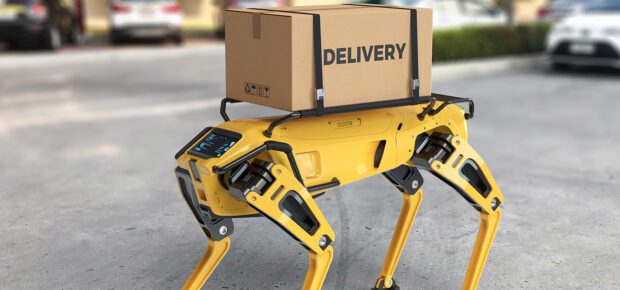December 1, 2022
If you are a fan of robots (and let’s be frank, who isn’t?), you’ve almost certainly seen one of those four-legged specimens jaunting around obstacle courses or serving as a goalie in soccer practice.
It’s common to refer to them as “robot dogs” and they seem to be everywhere, which begs the question: Why are so many robots shaped like dogs?
To answer that we checked in with two experts in the field of robotics, IEEE Senior Member Ming Liu and IEEE Member Jayakrishnan Thrivikraman Nair.
Liu says that the robot dogs are a subset of robots referred to as “quadrupeds,” which means “four-legged.” The reason they resemble dogs, rather than horses or rabbits, has to do with the knees – the big joints connecting the two largest segments of the legs.
“The knee of the dog’s limbs bend backward (toward the rear), while the horse’s knee bends forward,” Liu said. “Most quadruped robots, like Boston Dynamics’ Spot, MIT’s cheetah3 and Unitree’s Go1 adopt the backward knee design, which is consistent with the shape and appearance of a dog.”
“When the quadruped robot performs the task of going upstairs, the backward elbow design provides legs with a larger collision-free workspace,” Liu said. “When going downstairs, the situation would be reversed. The knee-forward design becomes more advantageous, so the robots mentioned above tend to walk backward to go downstairs. Also, there are quadruped robots that can switch the direction of the elbow.”
Dogs’ legs are simpler
Nair said that the dogs tend to have lower centers of gravity, and that makes them more stable.
“Dogs’ front legs differ significantly from those of tall animals, and the last link length is quite short in comparison. This also ensures that the form and proportion of the front and back legs are the same, making it simple to replicate hardware and control gait,” he said.
Advantages of four-legged robots
One of the most prominent uses of dog-shaped robots involves monitoring and inspection. They can be used in search-and-rescue operations or in places that are too small or too dangerous for humans.
“It is the simplest form of statically stable locomotion that can traverse challenging terrain,” Nair said. “It offers the best balance of cost, controllability, and ability to walk on rough terrains. With four legs, the design can move in three different gaits: the walk, trot and gallop.”
Comparing two-legged and four-legged robots
“Although biped robots can also perform similar tasks, the stability of the locomotion of bipeds lags far behind that of quadrupeds,” Liu said. “Besides, the cost of building and maintaining a biped robot is several times higher than that of a quadruped robot.”
Disadvantages of four-legged robots
There are a few drawbacks of quadrupeds,” Liu said. “They tend to have low energy efficiency. Most can only work for one hour before they need to be recharged. They can also be noisy because of their gait. Some people aren’t able to tolerate the noise, which might prevent them from becoming a part of our daily life.”
In-Depth: What are quadruped robots used for, and how does that impact their design? Those questions are answered in this article from the IEEE Robotics and Automation Society magazine.





 Meaningful Momentum or Running in Place?
Meaningful Momentum or Running in Place? AI Through Our Ages
AI Through Our Ages Liquid Infrastructure: Our Planet's Most Precious Resource
Liquid Infrastructure: Our Planet's Most Precious Resource The Impact of Technology in 2025
The Impact of Technology in 2025 Quantum and AI: Safeguards or Threats to Cybersecurity?
Quantum and AI: Safeguards or Threats to Cybersecurity? Why AI Can't Live Without Us
Why AI Can't Live Without Us Bits, Bytes, Buildings and Bridges: Digital-Driven Infrastructure
Bits, Bytes, Buildings and Bridges: Digital-Driven Infrastructure Impact of Technology in 2024
Impact of Technology in 2024 Emerging AI Cybersecurity Challenges and Solutions
Emerging AI Cybersecurity Challenges and Solutions The Skies are Unlimited
The Skies are Unlimited Smart Cities 2030: How Tech is Reshaping Urbanscapes
Smart Cities 2030: How Tech is Reshaping Urbanscapes Impact of Technology 2023
Impact of Technology 2023 Cybersecurity for Life-Changing Innovations
Cybersecurity for Life-Changing Innovations Smarter Wearables Healthier Life
Smarter Wearables Healthier Life Infrastructure In Motion
Infrastructure In Motion The Impact of Tech in 2022 and Beyond
The Impact of Tech in 2022 and Beyond Cybersecurity, Technology and Protecting Our World
Cybersecurity, Technology and Protecting Our World How Technology Helps us Understand Our Health and Wellness
How Technology Helps us Understand Our Health and Wellness The Resilience of Humanity
The Resilience of Humanity Harnessing and Sustaining our Natural Resources
Harnessing and Sustaining our Natural Resources Creating Healthy Spaces Through Technology
Creating Healthy Spaces Through Technology Exceptional Infrastructure Challenges, Technology and Humanity
Exceptional Infrastructure Challenges, Technology and Humanity The Global Impact of IEEE's 802 Standards
The Global Impact of IEEE's 802 Standards Scenes of our Cyber Lives: The Security Threats and Technology Solutions Protecting Us
Scenes of our Cyber Lives: The Security Threats and Technology Solutions Protecting Us How Millennial Parents are Embracing Health and Wellness Technologies for Their Generation Alpha Kids
How Millennial Parents are Embracing Health and Wellness Technologies for Their Generation Alpha Kids Space Exploration, Technology and Our Lives
Space Exploration, Technology and Our Lives Global Innovation and the Environment
Global Innovation and the Environment How Technology, Privacy and Security are Changing Each Other (And Us)
How Technology, Privacy and Security are Changing Each Other (And Us) Find us in booth 31506, LVCC South Hall 3 and experience the Technology Moon Walk
Find us in booth 31506, LVCC South Hall 3 and experience the Technology Moon Walk Virtual and Mixed Reality
Virtual and Mixed Reality How Robots are Improving our Health
How Robots are Improving our Health IEEE Experts and the Robots They are Teaching
IEEE Experts and the Robots They are Teaching See how millennial parents around the world see AI impacting the lives of their tech-infused offspring
See how millennial parents around the world see AI impacting the lives of their tech-infused offspring Take the journey from farm to table and learn how IoT will help us reach the rising demand for food production
Take the journey from farm to table and learn how IoT will help us reach the rising demand for food production Watch technical experts discuss the latest cyber threats
Watch technical experts discuss the latest cyber threats Explore how researchers, teachers, explorers, healthcare and medical professionals use immersive technologies
Explore how researchers, teachers, explorers, healthcare and medical professionals use immersive technologies Follow the timeline to see how Generation AI will be impacted by technology
Follow the timeline to see how Generation AI will be impacted by technology Learn how your IoT data can be used by experiencing a day in a connected life
Learn how your IoT data can be used by experiencing a day in a connected life Listen to technical experts discuss the biggest security threats today
Listen to technical experts discuss the biggest security threats today See how tech has influenced and evolved with the Games
See how tech has influenced and evolved with the Games Enter our virtual home to explore the IoT (Internet of Things) technologies
Enter our virtual home to explore the IoT (Internet of Things) technologies Explore an interactive map showcasing exciting innovations in robotics
Explore an interactive map showcasing exciting innovations in robotics Interactively explore A.I. in recent Hollywood movies
Interactively explore A.I. in recent Hollywood movies Get immersed in technologies that will improve patients' lives
Get immersed in technologies that will improve patients' lives